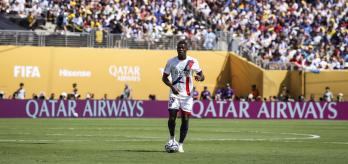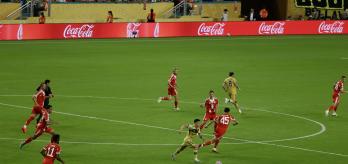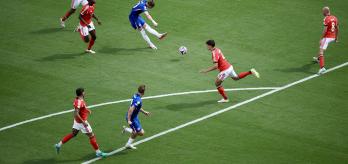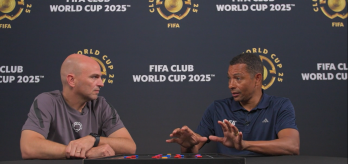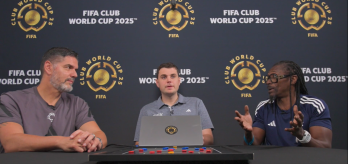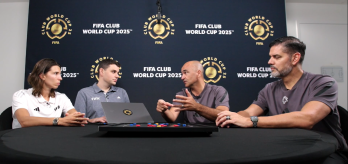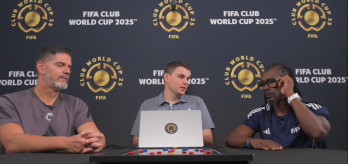FC Salzburg began their Club World Cup campaign with a 2-1 win over Mexico’s Pachuca at the TQL Stadium in Cincinnati, Ohio. The Austrian side’s three points took them top of Group H, ahead of Real Madrid and Al-Hilal. The Technical Study Group’s Tobin Heath analysed the game, and below, she explains why FC Salzburg’s 4-2-2-2 structure and systematic counter-press were central in overcoming an impressive Pachuca team. The article is based on a match review featuring Heath and Harry Lowe from FIFA’s Football Performance Insights Team.
Watch match review
Building up in a 4-2-2-2
Building up through a 4-2-2-2 is one of FC Salzburg’s defining tactical characteristics. The set-up consists of a back four and a chain of two centre-midfielders, two number 10s and two number 9s. This possession strategy was on display throughout the Austrian club’s match against Pachuca, and the four lines comprising the formation had the following responsibilities:
-
4 – The two centre-backs provided defensive solidity, and the two full-backs crucially pushed up the wings to provide width and act as attacking outlets during the latter stages of the build-up.
-
2 – The two central midfielders initiated attacks by passing into the four team-mates ahead of them. They also remained idle to cover the space vacated by their two full-backs, should they be caught in transition.
-
2 – The two number 10s found space between the midfield and defensive lines and overloaded central areas of the final third.
-
2 – The two number 9s combined with the number 10s, pulling the opposition’s team shape inward and providing space on the wings for the full-backs to receive and deliver the ball into the box.
The Austrian side managed to create numerous chances by progressing play into the congested central areas. Once the ball was played into the two number 10s or number 9s, these players would then spread the ball to their full-backs in the vacant wide channels. The full-backs, with time and space, could deliver accurate balls to their team-mates in the penalty area. Clip 1 is an example of this sequence from the first half.
In the clip above, the interaction between the players comprising the FC Salzburg formation stands out, explains Heath.
“There are a couple of different [important] relationships in this formation. First off, the relationship of the two 9s. The two 9s, for the majority of the match, really occupied the Pachuca centre-backs, keeping them relatively narrow…We also see the relationship between the 10s and the 9s. One of the 10s gets between the lines and makes it very difficult to defend, and creates a lot of indecision for the Pachuca full-back.
“We create these formats [situations] to create indecision for the other team. In this game, there was so much indecision because we had so many numbers in the centre of the park. We had a lot of width coming from FC Salzburg’s full-backs, and ultimately, the play would come inside for some central combinations. We found the ball outside with the right timing of the full-backs and an exceptional quality of technique for the cross. When you have the situation when you’re starting with so many numbers centrally, and the ball then goes out wide [to be crossed in], it’s easy to get numbers in the box.”
Counter-pressing identity
FC Salzburg’s structure when in possession is deeply rooted in their counter-pressing intentions. Having players in close proximity to the ball when in possession in central areas implies that there are strong numbers available to apply pressure immediately after turnovers.
“It’s almost like there is no line between attacking and defending with this team – it’s all part of one motion,” explains Heath. “The way you become a great pressing team is if you’re organised offensively. Sometimes, your best form of attack is losing the ball in these areas because it creates a bit of chaos, and then you’re able to pounce. You just see the attitude. For a lot of teams, when they give up the ball, they’re disappointed. This team understands they’ll turnover the ball.”
“In this clip, we see their identity and DNA when they lose the ball. The discipline to win it back immediately comes from every player on the pitch. What is most impressive about this style of pressing is that it is a sustained press. A lot of times in this tournament, we’ve seen pressing individually, covering or single defensive actions here or there. But [FC Salzburg] is collectively pressing around the pitch. Everyone is honed into the triggers. The body language – every single player is on the front foot. They’re hungry.”
If they did not win the ball back with the first press, players in the next wave would continue sustaining pressure. At times, the players involved in the counter-press would apply up to four phases of pressure after losing possession, meaning they would track four successive passes made by their opponents. This pressing mentality, coupled with the team’s deliberate organisation in possession, made it gruelling for Pachuca to escape.







